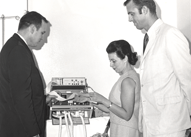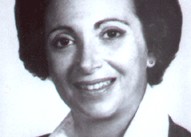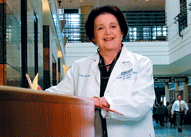

| Fall 2008 | |||||||||||||||||||||
| Current Issue | |||||||||||||||||||||
| The Hidden Truth about Alcohol A Voice for Grady The Trouble with Vaccine Trials Love Affair with the Heart Dean's Mesage In Brief Gifts and Support |
|||||||||||||||||||||
| Past Issues Other Publications Contact Us Make a Gift SOM home |
|||||||||||||||||||||



|
|||||||||||||||||||||
For a half-century, Nanette Wenger has tested long-held assumptions about cardiovascular disease among women and the elderly
By Sherry Baker
Nanette Kass was one of only 10 women out of a class of 120 when she received her medical degree from Harvard in 1954. Harvard’s 10-year probationary period for co-eds ended when her class graduated, and women at last were incorporated into the university charter.
But it never occurred to the high-spirited young New Yorker, a ballet-dancing, museum-loving daughter of Russian immigrants, that medical school, or being a woman in medicine, might be a problem.
“And it wasn’t. Trailblazing was exciting, and I was fortunate to have spectacular male mentors,” says Nanette Kass Wenger, chief of cardiology at Grady Memorial Hospital.
It also was the beginning of what she calls her “love affair” with her chosen specialty—studying, researching, and treating the heart.
In 1958, after completing a residency in medicine and a cardiology fellowship at Mount Sinai Hospital in New York City, Wenger moved to Atlanta. Her husband, gastroenterologist Julius Wenger, accepted a position at the Atlanta Veterans Affairs Medical Center, and Nanette soon joined Emory.
As a new faculty member in the Department of Medicine, Wenger was one of the country’s rarities—a “lady doctor” and one of only a handful of female physicians at Emory.
Grady’s mission of serving the medically indigent community appealed to Wenger. For about six months, she treated patients in the “old Grady”—two small buildings across the street from each other, one a hospital for whites only and the other a “colored” hospital, with limited facilities and resources. With the advent of a new building, Grady quickly became a springboard for applying the latest advances in cardiovascular diagnostics, surgery, and pharmacology.
It was a time not only of discovering new ways to test for and treat heart ailments, but also of learning about her patients as individuals. “I found out how fabulous they were—how much they valued family and friends, and their medical caregivers and how willing they were to participate in training young doctors and in research studies,” Wenger says. “I also learned that ‘honey’ was a label to be cherished.”
An integral part of the medical school and Grady ever since, Wenger became professor of medicine at Emory in 1971 and reared three daughters (two are physicians and one is a history professor) in the process. She also wrote more than 1,300 articles and book chapters, chaired conferences for the National Heart, Lung, and Blood Institute (NHLBI), and led numerous professional medical organizations and meetings. She is a longtime member of the Georgia Heart Association and served as its first female president. Two awards are named in her honor: the Wenger Award for Service, created by the Department of Medicine, and the annual Wenger Awards for Excellence, presented by WomenHeart, a national patient-led organization that educates and advocates for women with heart disease.
Although Wenger herself has earned dozens of awards, perhaps her greatest professional achievement, and the one that has brought her international recognition, was changing a major paradigm in cardiology: the assumption that heart disease affects only men. She also was one of the first physician-scientists to speak out about the under-representation of women in research studies and clinical trials. “Nanette clearly has been one of the most influential forces in helping shape our current knowledge of heart disease in women,” says Laurence Sperling, director of preventive cardiology at Emory.
Wenger continues to study women and heart disease, and the 2005 book Women and Heart Disease, which she co-edited with British cardiologist Peter Collins, is the standard medical text on the subject.
“All the studies derived from registries have shown that women with heart disease still remain under-treated,” Wenger says. Consequently, she works diligently on behalf of the Go Red for Women campaign, sponsored by the AHA and the NHLBI, to promote heart disease awareness among women.
During her journey through medical school, residency and fellowship training, and her early days on the faculty, female role models and female mentors in cardiology were notably lacking. That fueled her own drive to mentor women and men at the undergraduate and postgraduate levels.
Michele Doughty Voeltz is among those who credit Wenger with helping create opportunities for women cardiologists and women patients with heart disease at Emory. “I see a clinic made up mostly of female patients, ranging in age from their teens to their 90s,” says Voeltz. “I’m in the process of starting the Emory Crawford Long Women’s Cardiovascular Research Center, which will incorporate comprehensive clinical care and research opportunities for our female patients.” Wenger will help raise funds and serves as primary adviser for the clinic’s evolution. “We will lead the city, and potentially the Southeast, in our ability to care for women with heart disease,” Voeltz says.
In the same way that Wenger challenged unproven assumptions about women’s heart disease risk, she continues to replace long-held assumptions about cardiovascular disease and care of the elderly.
“We need accurate, fact-based data about this population,” says Wenger, a founder of the Society for Geriatric Cardiology and now editor-in-chief of the American Journal of Geriatric Cardiology. “Because of our Medicare orientation, ‘elderly’ has been defined as 65 and older. Where we really lack information is for octogenarians, the fastest-growing sub-population. They are poorly represented in clinical trials.”
During the past year, Wenger joined forces with Emory medical faculty, residents, and students to help rescue Grady from the financial black hole that threatened its existence. “Emory medical students and residents deserve the credit for the success of this effort,” she says. “They launched a campaign to save Grady and remained committed to their patients, the need for access to care for the underprivileged, and the importance of training physicians who will practice within our state,” she says. “They became leading citizens of Atlanta, and I’m so proud of them.”
With a new governing board in place and a growing infusion of new funds, Grady is poised to remain a top-notch teaching hospital where patients receive state-of-the-art care. “Now that Grady’s transition is beginning to take place, we can successfully recruit a new chief of cardiology for Grady,” says Wenger. But that doesn’t mean her love affair with cardiology is ending.
“My plans, at least for the short term, are to complete a number of research studies and manuscripts and continue teaching, which I cherish.”
Current Issue | Past Issues | Contact Us | Make a Gift
Back to Top | SOM home
© 2008. Emory University, All rights reserved.
Back to Top | SOM home
© 2008. Emory University, All rights reserved.